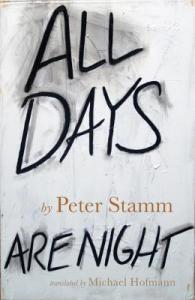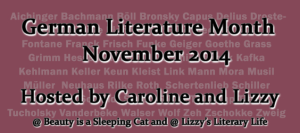Back to German Literature Month 2014 hosted by Caroline and Lizzy. I’ve mention already in my review of Silence that although I had a year to pick books to read for this event, I had no concrete plans other than to read something by Joseph Roth. As luck would have it, a blogging friend sent me an unwanted review copy of Swiss author Peter Stamm’s All Days Are Night. I’d been meaning to read something by Peter Stamm, and since it’s German Literature Month, this was a perfect opportunity.
Titles can give a hint about content, and in the case of All Days Are Night–a book which landed on my doorstep, and a book I knew absolutely nothing about, I had the impression that I was going to read something about sad, lonely people. I was right.
 All Days Are Night is mainly the story of Gillian, a successful, beautiful television personality whose life, as she knew it, is wiped out in a moment by a drunk driving incident. Gillian survives with her face badly damaged while her husband Matthias, is killed. No one, except Gillian, knows the details of the fight or why Matthias was driving home from a party in a drunken rage, and when she wakes up from the accident in the hospital, moving back and forth in a semi-hallucinogenic, heavily medicated state, she doesn’t initially remember what happened:
All Days Are Night is mainly the story of Gillian, a successful, beautiful television personality whose life, as she knew it, is wiped out in a moment by a drunk driving incident. Gillian survives with her face badly damaged while her husband Matthias, is killed. No one, except Gillian, knows the details of the fight or why Matthias was driving home from a party in a drunken rage, and when she wakes up from the accident in the hospital, moving back and forth in a semi-hallucinogenic, heavily medicated state, she doesn’t initially remember what happened:
Gillian tries to concentrate. Everything depends on her reply. She wants to be herself, to get up, but she can’t. She can’t move her legs; it’s as though she has no legs. The radio stops, the nurse walks over to the window and draws the curtains. Gillian remembers; the rain, the low-pressure area. There must be a connection.
You should try and get some rest.
Rest from what? Something has happened. Gillian is hovering around it, the memory, she is moving closer and then getting farther away from it again. When she puts out her hand, the pictures disappear, and the blue water comes instead, the blue water and the empty space. But the other thing is there all the time, waiting for her. She knows there is a way out, and she will take it. Later.
After Gillian realizes what happened that night, she keeps the truth about the fight with Matthias to herself. She must go through a series of surgeries to repair her face, but her life in front of the cameras it is gone. Gradually the backstory about exactly what Matthias and Gillian were fighting about floats to the surface. She has a lot to feel guilty about….
That’s really as much of the plot as I’m willing to give away, but I will say that the second part of the book brings in artist Hubert to the central stage. Both Gillian and Hubert have breakdowns for different reasons, and the story follows the connections between these two characters and how they deal with their problems.
Veering away from the plot, I’ll focus on Hubert’s art–he’s known for his photos of naked women. That may sound salacious, and indeed many people try to make Hubert’s work sound salacious, but the photos are of women mostly performing everyday tasks … naked:
In the next tray were pictures of a small woman with wide hips and large, pendulous breasts. She had short blond hair and hairy armpits. Both her posture and her facial expression had something theatrical about them. She hung washing on a low rack in a tiny bathroom, baby things and men’s socks. She took a book from a shelf, hunkered down on the floor, and swept up with a small broom, maybe crumbs from biscuits she had given her child. The apartment was cluttered and untidy. In the last pictures, the woman looked close to tears.
She looks terribly lonely, said Gillian. Do you have any idea what you put these women through?
They agree to take part, said Hubert, switching the trays. Even in their nakedness they try not to reveal themselves. They hide behind their movements, their smiles, their way of exhibiting themselves.
Identity and authenticity are central themes in the book, and all of the main characters seem to be trying to find authenticity in their lives by various means. Gillian, with her badly damaged face, can no longer appear in front of the camera, so she loses her career, but even before the accident, she begins to feel that she’s “playing a part in a bad film” or “speaking lines from a script.” After the accident she looks in the mirror, sees a fragmented self and later realizes that her life “before the accident had been one long performance.”
It’s easy to see how an artist would constantly strive for authenticity, but in Hubert’s case, his drive is different. He feels like an “imposter” when he teaches, and when he asks his models to remove their clothes it’s as if in so doing, their nakedness will reveal an absolute truth–a tactic which fails, of course. Perhaps he’s driven to seek authenticity for another reason. His girlfriend (later in the book they’re married) is a seeker of some sort of deeper truth, but she’s hollow and superficial:
Astrid pursued her interest in energy and the body. Hubert wasn’t impressed by the esoteric life-help scene she started to move in. He passed occasional ironic remarks, to which she reacted so violently that he didn’t say anything the next time she registered for a weekend course in psychodrama or breathing therapy.
There’s also a terrific sense of emptiness and abandonment in this novel which is partly achieved through a complete absence of quotation marks (see the first and second quotes), but also Stamm’s spare style in this unpredictable, melancholy, yet ultimately optimistic story underscores a deep void which runs through the lives of his lonely, troubled characters.
Gillian clicked on “Gallery.” There were five pictures of unoccupied rooms: an office, a bedroom, a living room, a kitchen, and a bathroom. In all the pictures it was nighttime, and the rooms were dimly lit. Although not much could be seen, Gillian still had the sense that there was someone in all the rooms, hiding in a corner or else behind the onlooker.
Translated by Michael Hoffman. 182 pages.


I wasn’t sure whether I wanted to read this or not but it sounds like a typical Stamm, which means, yes, I would like to read it. I thought it wasn’t out in English yet. The sense of emptiness and abandonment is quite typical for Stamm. His protagonists are often strangers abroad.
Strangers abroad, eh? Can you point me to one of those?
Most of his short stories and some of the novels like On a Day Like This.
He doesn’t write about people on holifays though but about expats.
I’ve been meaning to read something by Peter Stamm for some time, and I have his ‘We’re Flying’ collection of stories on the kindle so I guess I should start there. I like the sound of the themes and style here, the ideas around identity, the sense of emptiness and abandonment you mention.
Funny isn’t it how these names float around and we intend to get to them but somehow don’t quite do it.
Yes, and I keep forgetting about this collection as I tend to reach for a paperback from the shelves when I’m deciding what to read next. I’ll get to it at some point as he sounds excellent.
He sounds very good indeed.
I bought Agnes, we’ll see how good it is.
Have you read it, Caroline?
Oh good. Now I’ll be able to see what you think of another title I haven’t read but may be interested in.
Guy,
Thanks for writing a review of this. It sounds fascinating and is not one I’m likely to pass up.
Judith (Reader in the Wilderness)
You’re welcome. I hope you enjoy it.
And here I am living on the Swiss border and not reading Swiss writers – thanks for giving me the nudge – this sounds really interesting…
Great review Guy.
The plot sounds very dark and down. That is not necessarily a bad thing.
I believe the last novel that I read that had dialogue without quotation marks was Cormac McCarthy’s Blood Meridian. I generally like such experimental writing.